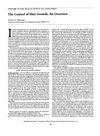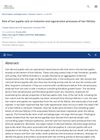Cultured Dermal Papilla Cells of the Rat Vibrissa Follicle: Proliferative Activity, Adhesion Properties, and Reorganization of the Extracellular Matrix In Vitro
December 1997
in “
Archives of Dermatological Research
”
TLDR Rat dermal papilla cells have unique properties and interact differently with their environment compared to other skin cells.
The study investigated the functional properties of cultured dermal papilla cells (DPC) from rat vibrissa follicles and compared them to dermal fibroblasts (DFB). DPC exhibited an aggregative growth pattern and lower proliferation rates than DFB. Adhesion assays revealed that DPC had significantly higher adhesiveness to collagen type IV, a key component of the basement membrane of dermal papillae. DPC also showed a lower capacity to reorganize extracellular matrix components and completely lysed collagen lattices after 48 hours in culture. These functional differences were associated with higher expression of integrin adhesion receptors in DPC. The findings indicated that DPC are a specialized cell population with distinct properties related to cell-matrix interactions in the hair cycle.






